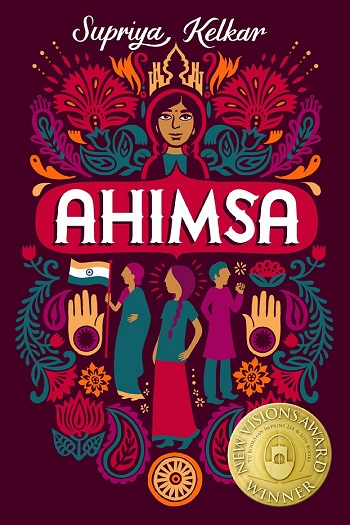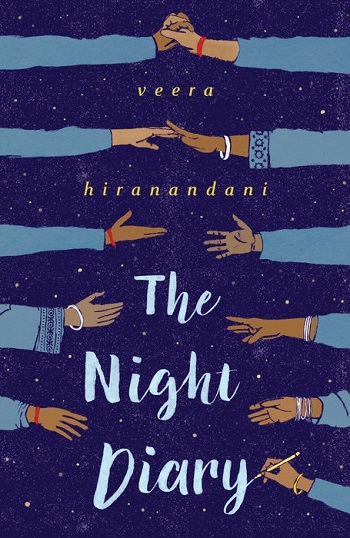My 10-year-old son finally wanted to read about the Indian subcontinent’s independence movement, but had a condition set in stone — it had to be a compelling story. No fact-heavy, plot-starved novels, he begged. And I found I had a condition too — nuance. The books and graphic novels I’d read were often overtly jingoistic, and not quite suitable for South Asian kids raised outside in the West, often in mixed-race families. You know what I mean.
After many moons of fruitless searching, I found not one but two books that blew past our requirements. Supriya Kelkar‘s Ahimsa (Tu Books, 2017) provides a lucid, thoughtful explanation of the ethos and evolution of India’s journey to self-governance. It also acts as a welcome antidote to Empire defenders with their rallying cry of “But the railways!” Nope, dudes.

It’s 1942, and Gandhi, jailed by the British, has urged Indians to strike so the British “Quit India” already. Gandhi asks for peaceful civil disobedience, based on the principle of ahimsa or non-violence — to never hurt anyone. Young Anjali, fired with patriotism, decides to paint a large Q (short for “Quit India”) on the local British officer’s house. After all, the British won’t hang a ten-year-old girl…or will they? Anjali’s mother used to be the officer’s secretary, but then resigned. Or was she let go? It’s all very complicated, but one thing is clear to Anjali: her duty lies in fighting injustice, beginning with a little well-intentioned vandalism. And then the Gandhian movement comes to Anjali’s backyard, when Anjali’s mother becomes a freedom activist.
Anjali is courageous, stubborn, intelligent, and most importantly, capable of critical thinking. Even as she’s protesting the indignity of British rule, which considers Indians as unfathomably inferior to white folks, she gradually realizes many Indians are similarly culpable of cruelty to their own people. The caste system she’s never questioned (she’s upper caste) treats the low caste Untouchables inhumanely — just like the British treat Indians. And once sensitized to injustice, Anjali is forced to question her own attitudes — towards Muslims, towards the caste system and its deep roots in Hinduism, and even towards Gandhi, whose Hinduism-based approach to helping lower castes might have more than a whiff of condescension.
“The caste system she’s never questioned (she’s upper caste) treats the low caste Untouchables inhumanely — just like the British treat Indians.”
If you think it’s getting a tad preachy, rest assured Kelkar paces the novel beautifully — the 8-14 crowd learns about India and British colonial rule along with Anjali. It’s lovely to watch our young heroine’s transformation from one of the NIMBY crowd to a principled fighter who does the right thing even when it’s hard physically, intellectually, and emotionally. In all, Kelkar does a superb job of balancing historical detail with the honest-to-goodness confusion of a ten-year-old figuring out her role in a turbulent world. Ultimately, Anjali captures our hearts with her vulnerability, her compassion, and her determination to be the change she wishes to see.
And what about the actual independence, asked my son. Well, it was complicated, I replied, for in the wake of the joy of British quitting India came tragedy, when the region was partitioned into two separate countries. Fourteen million people were displaced as Muslims headed north to Pakistan and Hindus and Sikhs went south to India, and at least a million lives were lost during the largest human exchange EVER.
Veera Hiranandani’s epistolary novel The Night Diary (Dial Books, March 2018) is based on her father’s 1947 journey as a partition refugee from Mirpur Khas in Pakistan to Jodhpur in India. She wrote the novel for readers whose family went through partition, as well as for those who haven’t heard about this event despite it being a huge piece of our global history.

The story opens on Nisha’s eleventh birthday in July 1947, when she’s gifted a diary by the family’s beloved retainer Kazi. Nisha decides that night is the best time to update her diary, as “that way, no one will ask me any questions.”
Nisha is smart, sensitive, silent, and surrounded by love. Her mother died in childbirth, but Nisha’s Papa, a doctor at Mirpur Khas City Hospital, her grandma Dadi, her twin brother Amil and Kazi all live together in harmony. While Papa is always busy and often distant, Kazi is both mother and father; through his solid, unconditional love and tutelage, shy, introverted Nisha finds she can express herself through cooking for those she loves.
But “sometimes the world as you know it just decides to become something else.” India is to be divided into two separate countries — and Mirpur Khas will be in Pakistan. As riots erupt around them, Nisha learns grown-ups don’t have all the answers, and that adults can be scared too. She also learns all about the awful necessity of taking a side — Hindu or Muslim. Nisha’s father is Hindu and Mama was Muslim; heartsick, Nisha writes, “Me, Amil, Papa, Dadi, and Kazi. That’s it. That’s the only side I know how to be on.”
“As always, the question of her mixed Hindu-Muslim parentage hangs over Nisha; will people always hate one half of her?”
On August 14, 1947, their home is in India no more, and the family packs their belongings. It’s wrenching, leaving behind almost everything for the unknown people who’ll occupy their house, but it’s unbearable that they go without Kazi, who, as a Muslim, must stay in Pakistan. Hiranandani is deliberately even-handed about the political aspects — there’s no blaming any side or people or religion. “All those in power wanted peaceful relations between the groups, but disagreed on the best way to make that happen.”
As rioters draw closer to home, the family flees on foot to India. As always, the question of her mixed Hindu-Muslim parentage hangs over Nisha; will people always hate one half of her? After walking fifteen miles a day, the family sleeps in the open, with a fire to keep animals away. Food is scarce, water even scarcer, and tempers fray as the stress of survival gnaws at them. In their time of crisis, everything non-essential is pared away until all that’s left is the fear they will die of starvation/dehydration, or be murdered by rioters, before reaching the border. Will they arrive in India with their family unit — and their faith in humanity — intact? (Spoiler: it’s a kid’s book, so everything turns out okay-ish.)
Both books not only compellingly encapsulate this slice of India’s history, but also connect it to contemporary global events. In Hiranandani’s hands, the Partition isn’t something that happened in a remote place ages ago, but an urgent lesson on how quickly things can go to pieces among people who’ve lived in amity for centuries. And of course, Nisha’s experience as a refugee is no different from the experiences of refugees and immigrants facing xenophobia today. The parallels between Anjali’s struggles against the British and today’s social justice movements are also evident, for the problem Anjali faces is a universal one: people resisting change when it results in the loss of their (unfair) privilege and power.
Both authors mention the lack of books featuring Indian history in their own childhoods; I’m so elated they’ve remedied that situation for this generation of kids. And yes, my son who dreams of Camp Half-Blood and Hogwarts loved these books. Thanks, Supriya and Veera; my job here is done!
***
Niranjana Iyer lives in the San Francisco Bay Area, where she works as a writer, editor, and book reviewer. She blogs at niranjana.wordpress.com and tweets at @ninaiyer.












